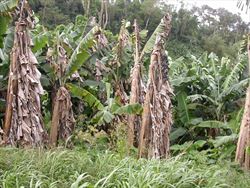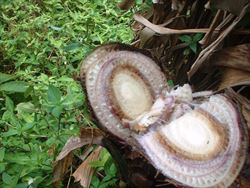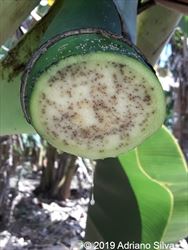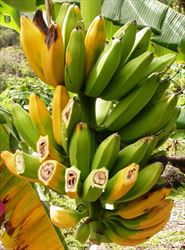Moko disease. Note, moko is caused by the same bacterium (Ralstonia solanacearum) that causes bugtok in the Philippines). Moko is the name used to describe the yellowing of leaves and wilt on Cavendish (AAA*) bananas grown on plantations, whereras bugtok is the name used to describe rots of flowers and fruits on cooking bananas (ABB/BBB) grown in the Philippines by smallholders for local markets (see Fact Sheet no. 524). This fact sheet describes the disease on Cavendish AAA varieties ground by smallholders.
Pacific Pests, Pathogens, Weeds & Pesticides - Online edition
Pacific Pests, Pathogens, Weeds & Pesticides
Banana moko disease (525)
Ralstonia solanacearum race 2, biovar 1; previously, it was known as Pseudomonas solanacearum, Burkholderia solanacearum. Recently, molecular analysis moko disease (and that causing bugtok in the Philippines), puts race 2 in Phylotype 11 on origin (American) and evolution. There are several strains. Bugtok and moko are considered to be one and the same disease, but expressing different symptoms in different banana varieties (see Fact Sheet no. 524).
Asia, Africa, North (USA, Mexico), Central and South America, the Caribbean, Oceania. It was eradicated on Heliconia in Australia. In the USA, it is present in Florida (banana), and Hawaii (Heliconia). Moko is recorded in Guam on banana, the only known country or territory within Oceania.
Banana, plantain, Heliconia, and a number of weeds, some are hosts without showing symptoms. It is suggested that the bacterium is endemic in forests of Latin America and the Caribbean.
A serious disease of banana with symptoms similar to those of bugtok and blood disease (see Fact sheet nos. 522, 524). Leaves turn yellow and wilt (Photo 1), brown streaks and stains appear in the stem (leaf sheaths), often concentrated in the central core (the stem with supports the leaves and flower/fruit stalks) (Photos 2&3). Flower stalks show vascular staining (Photo 4), and the male 'bell' blackens (Photos 5&6), and there is uneven and premature ripening of the fruit, with firm brown or grey rots inside (Photos 7&8). Vascular tissues of both stem and flower stalk produce a creamy bacterial ooze when cut.
The way plants become infected determines the sequence of symptoms. If infected from the roots or rhizome, yellowing and wilting of the older leaves occurs and they collapse. If infected through the male flowers by visiting insects carrying bacteria, then flower buds and the flower stalks become black and shrivelled, fruits rot, leaf sheaths become infected and plants collapse and die.
Spread over relatively short distances occurs in a number of ways: (i) by insects visiting male flowers and the scars left by leaf-like bracts which ooze liquid containing the bacterium; (ii) in flood or irrigation water; (iii) in suckers taken from infected mother plants; and (iv) on knives during cultural operations, e.g., pruning and de-suckering. Long distance spread is associated with movement of infected fruit and suckers in exchanges between farmers. Survival occurs in soils for several years, aided by colonisation of weed. Survival in banana waste is for a short time only, and not considered important in the epidemiology of this disease.
Note, differences between strains: some more likely to be transmitted by insects, or through root contact and contaminated tools for pruning and de-suckering.
Bananas are a major staple in Africa, Asia and Latin America. Only 13% of production is traded internationally indicating its importance on domestic markets and for food security. Historically, black Sigatoka and Fusarium wilt (see Fact Sheet nos. 02, 176) have been considered the most important diseases of bananas. In recent years, moko has become the most important constraint to plantain and desert banana after black Sigatoka. Whereas commercial Cavendish plantations of desert bananas maintain a rigid set of production protocols to control moko, farmers growing plantains generally lack the resources to deal adequately with the disease. In Colombia, for instance, moko has reduced plantain production in the main growing areas, forcing farmers to seek alternative crops.
Look for yellowing leaves that wilt, fruits that ripen prematurely on the bunch with brown discouration of the pith, and brown streaks in the stem. However, it is difficult to identify moko on symptoms alone. PCR analysis is recommended. Several other diseases have symptoms in common, as follows:
- Moko and blood disease: leaves become yellow, droop and finally collapse, fruits show internal rots; discolouration of vascular system with ooze.
- Bugtok: infections are not (rarely) systemic and leaves do not wilt; male bacts fail to fall and blacken; internal fruit discolouration. Bugtok only affects cooking bananas (ABB/BBB) in the Philippines.
- Fusarium wilt (Panama disease): leaves become yellow and wilt; no fruit symptoms; discolouration of vascular system, but no ooze.
BIOSECURITY
Countries where bananas are important as an export crop and/or a staple food and, as yet, free from moko, should take all necessary precautions to prevent its further spread. Moko is a disease more widely present than bugtok (Philippines), the same bacterium but only on ABB/BBB varieties. It also occurs there on AAA Cavendish. Precaution is warranted; even though moko is unlikely to be introduced on desert bananas into disease-free areas, it has shown how it can spread in plantains in Central and South America, the Caribbean and elsewhere.
Where official transfers of banana, including its wild hosts, are required, these should follow the FAO/IBPGR Technical Guidelines for the Safe Movement of Germplasm. No. 15. Musa. 2nd Edition, (http://www.bioversityinternational.org/uploads/tx_news/Musa_spp.__2nd_edition__502.pdf). These state that germplasm should be transferred as virus-indexed plantlets growing in a sterile tissue culture medium.
CULTURAL CONTROL
The recommendations given are for smallholders. The disease occurs in large-scale Cavendish plantations through pruning tools, but it is relatively rare due to frequent monitoring, infected mats are quarantined and treated (by slow-burning rice hulls), and fruits are bagged, preventing insects from spreading the bacterium to the flowers.
If smallholders lack the resources to carry out all the recommendations below, they should focus on the three that are most important: (i) monitoring, and removal of disease plants as soon as they are seen, chopping all plants in the mat into pieces and burying in the same place, (ii) removal of the unopened male flower 'bells' using a forked stick (called 'de-budding'), and (iii) keeping cutting tools clean and free of bacteria by frequent wiping with bleach (3% sodium hypochlorite).
Before planting:
- Do not plant near plots that have the disease, or near alternative hosts, e.g., tomato. Do not plant suckers down-wind from diseased plants. Insects may spread bacteria from diseased to healthy plants.
- Ideally, plant suckers only from healthy mats, those that have been monitored. If government-certified schemes are available, invest in clean planting materials.
During growth:
- Monitor:
- Check (monitor) farms frequently for symptoms of moko on leaves and on the male flower parts.
- Treat:
- Destroy diseased mats by injecting plants with herbicides or by cutting out plants at soil level. Chop and bury or, when dry, burn the diseased plants on site, including infected fruits.
- Bag the young inflorescence (flowers) as it emerges and bends down. Polyethylene, muslin or fine nylon mesh bags can be used. Remove the bags after the fruits are set, if followed by removal of the male parts.
- Remove male bells (de-budding) immediately after the last hand emerges. Ideally, a forked stick used to twist the male bell and remove it, rather than cutting it off with a machete which might be contaminated with bacteria.
- Hygiene:
- Clean tools (especially knives used for de-suckering and removing diseased plants) and machinery by wiping with bleach (3% sodium hypochlorite), remove soil from footwear, and prevent animals and vehicles moving through diseased areas to those that are healthy.
- Limit access by visitor/workers into banana farmers, especially if there are disease outbreaks..
- Isolate diseased mats by digging channels around them to limit movement of Ralstonia in run-off water.
- Remove alternative hosts, e.g., weeds that will increase the time the soil is contaminated by Ralstonia bacteria.
.After harvest:
- Carry on monitoring and treating plants if symptoms are seen.
- If actions fail to control the disease, grow alternative crops, fallow the land, or plant a legume cover crop, such as Mucuna for at least 12 months.
RESISTENT VARIETIES
Cavendish (AAA) varieties are less likely to be infected by insects under smallholder conditions; this is because insects are not as attracted to their flowers as they are to cooking bananas (ABB/BBB) with their wide-opening bracts and especially sweet nectar. However, Cavendish varieties are susceptible to infections from the soil, and from contaminated tools used for pruning and de-suckering. In the 1960s, variety Pelipita was distributed in Central America as a substitute for Bluggoe as it escaped infection from moko because of persistent bracts and male flowers. Selections from within collections of diploid (AA) varieties have been made in Brazil, with a variety from New Guinea (Babi Yadefana) showing resistance.
CHEMICAL CONTROL
Not a method to use for the control of this disease.
AUTHOR Grahame Jackson
Information from Blomme G, et al. (2017) Bacterial diseases of banana and enset: Current state of knowledge and integrated approaches toward sustainable management. Frontiers in Plant Science. (https://www.frontiersin.org/articles/10.3389/fpls.2017.01290/full#B66); and (including Photo 1)Liberato JR & Gasparotto L (2006) Moko disease of banana (Ralstonia solanacearum). PaDIL - http://www.padil.gov.au; and CABI (2021) Ralstonia solanacearum race 2 (moko disease). Crop Protection Compendium (https://www.cabi.org/cpc/datasheet/44999); and Moko (Undated) Fact sheet. Plant Health Australia. Queensland Government and Australian Banana Growers' Council Inc. (https://www.planthealthaustralia.com.au/wp-content/uploads/2013/01/Moko-FS.pdf); and Kemelyn Douglas (Undated) Control of moko diseased, Ralstonia solanacearum, race 2, biovar 1. CABI Plantwise Knowledge Bank. (https://www.plantwise.org/KnowledgeBank/factsheetforfarmers/20137804483); and Biosecurity Australia (2008) Final Import Risk Analysis Report for the Importation of Cavendish Bananas from the Philippines, Part C. Biosecurity Australia, Canberra. (https://www.awe.gov.au/sites/default/files/sitecollectiondocuments/ba/plant/bananas-philippines/PART_C_-_FINAL_-_COLOUR_COVER_AND_B-W_REST_-_John_081106.pdf); and from Álvarez E, et al. Current status of Moko disease and black sigatoka in Latin America and the Caribbean, and options for managing them. Cali, CO: Centro Internacional de Agricultura Tropical (CIAT); Food and Agriculture Organization of the United Nations (FAO), 40 p. (CIAT publication No. 404). (https://www.fao.org/3/i3400e/i3400e.pdf). Photos 1,2,5&7 Emmanuel Wicker, Plant Health Institute of Montpellier, CIRAD, Montpellier, France. Photos 3,4,6&8
Adriano Freire Silva, Instituto Agronomico de Pernambuco (Agronomical Institute of Pernambuco), Estação Experimental de Belém de São Francisco, Brazil.
Produced with support from the Australian Centre for International Agricultural Research under project HORT/2016/185: Responding to emerging pest and disease threats to horticulture in the Pacific islands, implemented by the University of Queensland, in association with the Pacific Community.
*The codes ABB and BBB are the amount of Musa acuninata and Musa bulbisiana (parents of many banana varieties grown) represented in each banana variety. An internationally recognised scoring system is used to determine the proportion.











